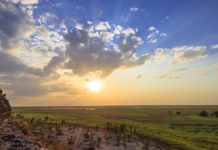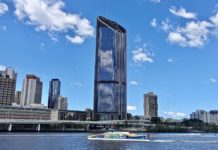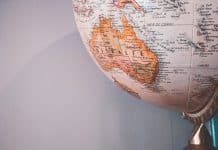
The Red Centre of Australia is a land of endless possibilities, incredible colours and unforgettable adventures. For many, it’s the perfect place to go on a road trip, where the expansive landscapes force you to slow down and enjoy the moment. If you want to experience the Red Centre of Australia, you have two main options. The first option is to join a tour group. A second option is exploring the area by going on a road trip in a motorhome/campervan.
Table of Contents
How to Explore the Area?
Organised tours
Australia’s Red Centre is huge, but it’s still possible to see most of the highlights in just 3-4 days with an organised tour.
Here are some of the best tours on offer:
- 3 Days tours departing from Alice Springs or Ayers Rock
- 4 Days tours departing from Ayers Rock
- A helicopter flight over the Red Centre from Yulara.
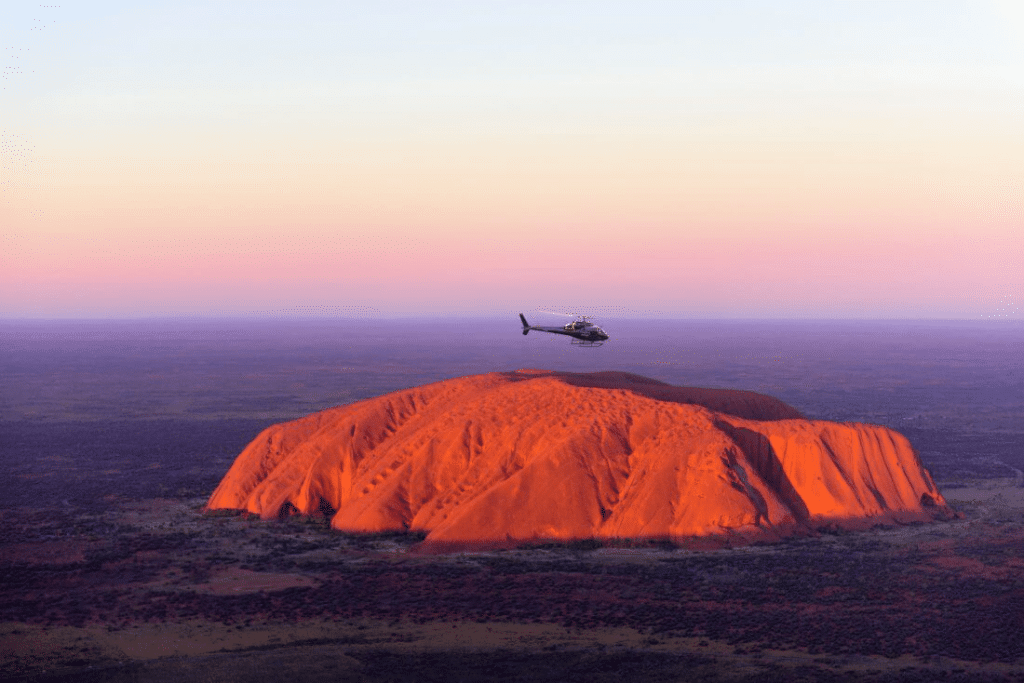
Road trip in a Campervan / motorhome
Time and distances involved
We recommend you give yourself about 10 days of travel from Alice Springs. However, it is possible to do this road trip faster – 7 days if you don’t waste any time, and 5 days if you only visit Uluru and Kata Tjuta. It’s also possible to fly directly to Ayers Rock Airport (Uluru) to save time. Bear in mind, though, that it’s not possible to rent a motorhome from here, only a car. Located in the middle of the Australian desert, visiting Uluru takes on another dimension when you realise the vastness of the region! That’s why driving to get there can actually be a valuable part of the trip.
Distances
Alice Springs – Uluru: 463km
Uluru – Kings Canyon: 320km
Kings Canyon – Alice Springs: 474km
MacDonnell Ranges (AR Alice Springs): 260km
TOTAL over 10 days: approx. 2000km
What type of vehicle do you need?
Contrary to what some may think, a 4WD is not necessary to explore this region. All major sites are accessible via a tarmac road. Also be warned that 4WD rental is quite expensive in Australia, so don’t spend extra money for no reason! The only advantage of having a 4WD in this region is that you can take the Mereenie Loop, which connects Alice Springs to Kings Canyon via a 322km track (vs 475km by road). If you have a 4WD you can also see more of the eastern part of the MacDonnell Ranges, the many sites of which are accessible by unpaved tracks.
Best time to visit the Red Centre
In summer (December to February), temperatures are between 20 and 35°C. In winter (June to August), they range from 3 to 20°C.
Autumn and spring are the best seasons to visit this part of Australia. April and May are among the nicest months in Alice Springs. September and October are also pleasant months to visit the Red Centre, it is also the time of year when colourful flowers pepper the desert.
Read more: Climate zones and seasons in Australia
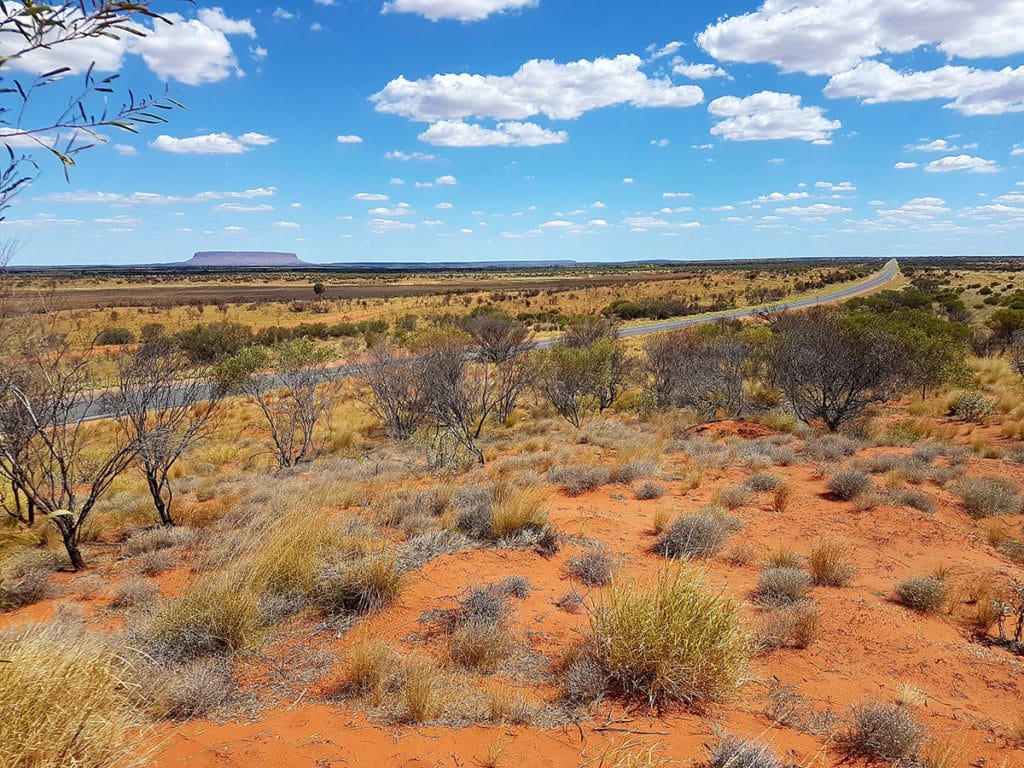
Recommended road trip itinerary (10 days)
Alice Springs – Uluru: 2 days
When you arrive at Alice Springs Airport you will need to pick up your vehicle (budget about $40 taxi fare between the airport and the city). We advise you to stock up on food and then leave the city to sleep in a free rest area south of it. The next day will be mainly dedicated to driving to get closer to Uluru. There’s not much to do on the road. However, you will be able to stop at Road Houses (Outback gas stations), where you can refuel, pick up snacks and souvenirs and stretch your legs. We recommend you stop for the night a few kilometres from Uluru, so you can get there early the next day. You have to pay to enter the park ($38) and your ticket is valid for three days, so if you go in the morning you can make the most of it. If you want, you can also request an extension of your pass, allowing you to stay five days.
Uluru: 2 days
To explore Uluru and the area around it, we recommend staying for 2 days. The first day will allow you to take a short walk around, go to the Cultural Centre to learn a little more about the site and the Aboriginal culture and possibly end the day by watching the sun go down. On the second day, you can (for example) start with the sunrise and then continue with a long walk around the rock (it’s always better to do this type of walk early in the morning to avoid the hot weather).
You can sleep at the only campsite available in the area – Yulara, which includes a caravan park, hotels, shops, a shopping centre etc. Be aware that you can only buy alcohol in Yulara if you are a client of one of the hotels or the caravan park.
Things to do
- Sunrise: Parking is specially provided for admiring Uluru at sunrise. We recommend you go there at least 30 minutes before sunrise in order to get a good spot. This is definitely a must during your visit to the Red Centre.
- Sunset: Another car park is also provided to admire Uluru at sunset. It is recommended to go there at least 1/2 hour before sunset in order to have a good place.
- Long walk around the rock: The “Base Walk” allows you to walk 10.6km around the rock. This is an easy walk and takes 3-4 hours.
- Short walks: There are also four short walks around the rock, from 1 to 4km.
- Cultural Centre: You will find a Cultural Centre at Uluru, which contains information about Aboriginal culture, art galleries, shops etc. A cultural/nature presentation also happens every day of the week at 10am.
All available walks can be found here.
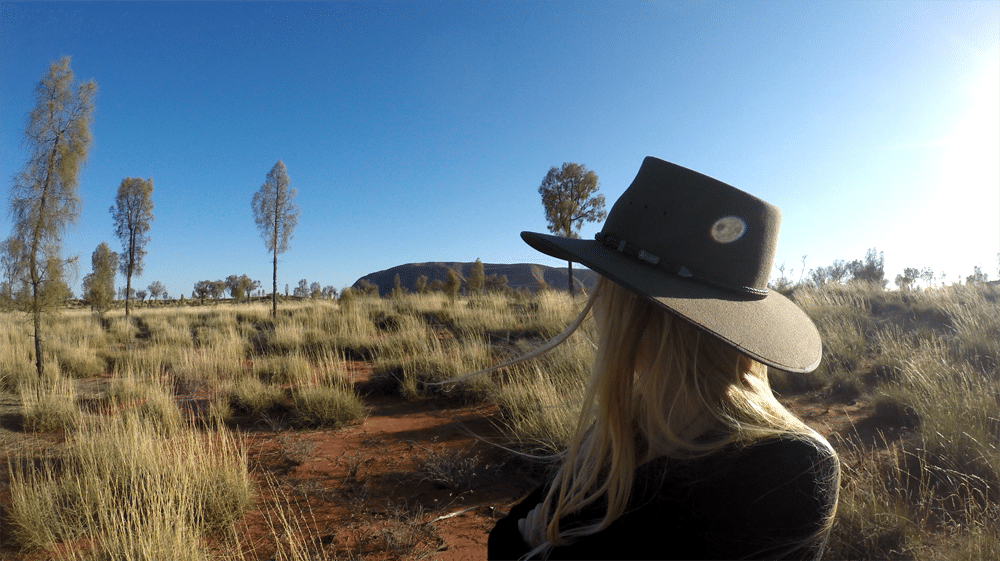
Kata Tjuta: 1 day
The Kata Tjuta or Monts Olgas are located 40 km from the campground or 25km from Uluru, so give yourself 20 to 30 minutes to get to the site. The highest of the 36 domes culminates at 1070m and dominates the surrounding plain.
Things to do
- We recommend doing the long Valley of the Winds walk in the morning. Allow about 4 hours to complete the 7.4 km path. The site is stunning and very few tourists do the full walk, so you might have the place to yourself! Make sure you bring water as it is very hot in the valley. Two water points are also available during the walk.
- You can also take the short Walpa Gorge walk, which takes around 30 min.
- The sunset over the Olgas can be viewed from the parking lot.
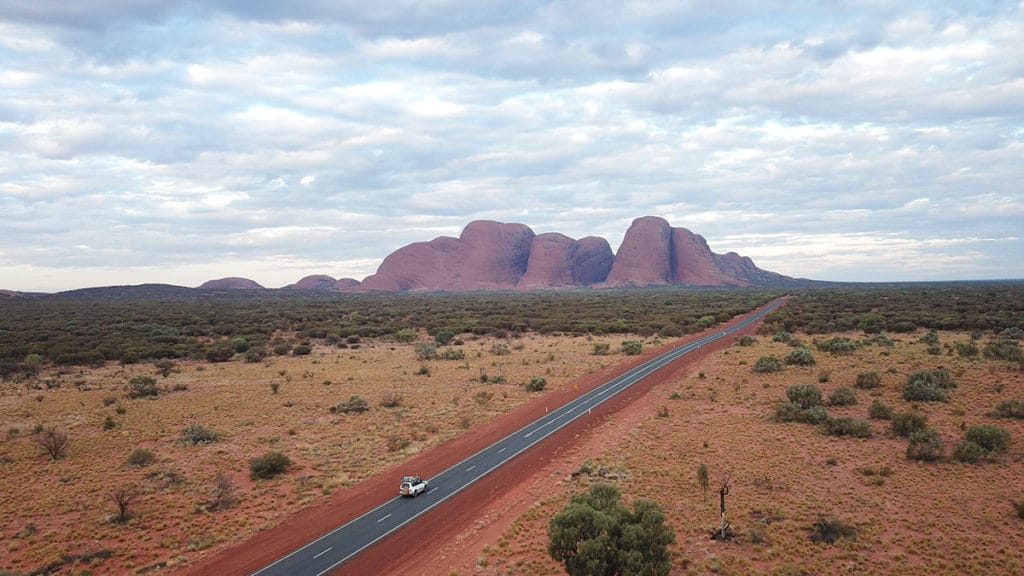
Kings Canyon: 1.5 days
Give yourself about 1.5 days for this because the drive to Kings Canyon from Uluru is over 300km. Kings Canyon is a canyon located in Warrtaka National Park. The site is accessible for free.
Things to do
The short Kings Creek Walk is a 2km round trip in the heart of the canyon. This walk runs along the bed of the river and can be done in the afternoon because it is very shaded.
Don’t miss the Kings Canyon Rim Walk, a 6km loop on the upper part of the canyon. Allow 3 to 4 hours for this walk. The walk begins with a difficult path that leads to the top of the canyon. In the middle of the walk, a detour leads to the Garden of Eden, a permanent water hole. Remember to bring enough water with you as no water point is available during the walk.
For experienced walkers, Giles Track, a 22 km route, connects Kings Canyon to Kathleen Springs.
If you want to stay 2 days in Kings Canyon, you can sleep at the resort located a few kilometres away from the site ($25 per person for sites without electricity and $30 with electricity). The caravan park is very popular with dingoes, so be careful. The sunset can be admired from an observation platform located a few meters from the caravan park.
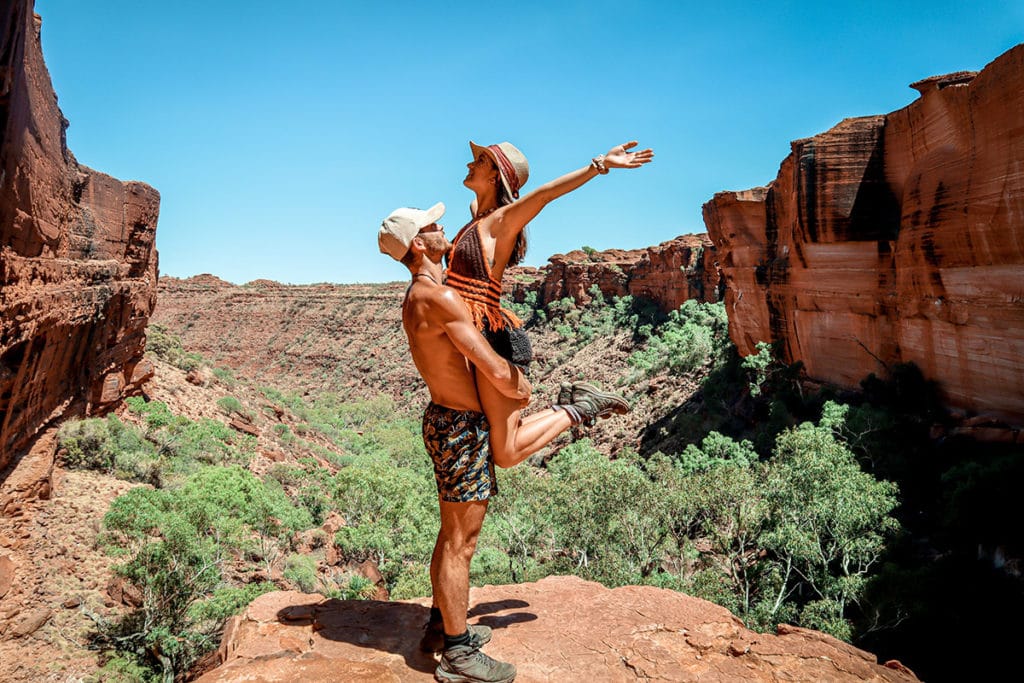
Alice Springs return: 1.5 days
From Kings Canyon, you have around 300km to cover. Depending on how much time you have, what type of vehicle you are driving etc. the journey can take a day or a little longer. If you can, you can spend some time in Alice Springs. There is not much to visit on the way apart from the few typical roadhouses.
MacDonnell Ranges: 1.5 days
The MacDonnell Mountains form a 650km long mountain range and separate Alice Springs in two. There are two parts to discover, the East part and the West part. There are more things to see in the West part.
West of the MacDonnell Ranges
This part of the ranges is accessible via a paved road (Larapinta drive). The sites are then accessible via unpaved roads but are often short distances.
The first site to visit is the Simpson Gap, where a nice walk takes you to a water hole. From this site, the departure points for two different walks (10 and 23km) are accessible.
Ellery Creek Big Hole will be a perfect spot for a swim and picnic by the water. The Dolomite Walk (3km) will take you about an hour and a half. The site is accessible via a 2km dirt road.
A 300m walk from the car park will take you to the Ochre Pits, ochre cliffs whose colours are used during sacred ceremonies.
At 8km from the main road, Ormiston Gorge is worth a detour. You can take a short walk there to reach a permanent water hole or the Gum Ghost Walk, which is a 2.5km loop. This walk leads first of all to a viewpoint (20min walk) then makes a loop on the gorge and ends up joining the water hole where you can refresh yourself. Possibility to camp on this site ($10) or to have a drink or a snack at the visitor center.
On the western part, you can also visit the sites of Serpentine Gorge or Chandley Chasm (ticketed). This part can be done in one day, however, if you plan to do long walks, you will need two days.
East of the MacDonnell Ranges
Via a paved road, you can access the sites of Emily Gap and Jessie Gap Natural Park, where you can admire rock paintings.
Trephina Gorge and N’Dhala Gorge are also worth seeing if you visit the eastern part.
We advise you to do a few sites on the way out and others on the way back because you will be taking the same route both ways.
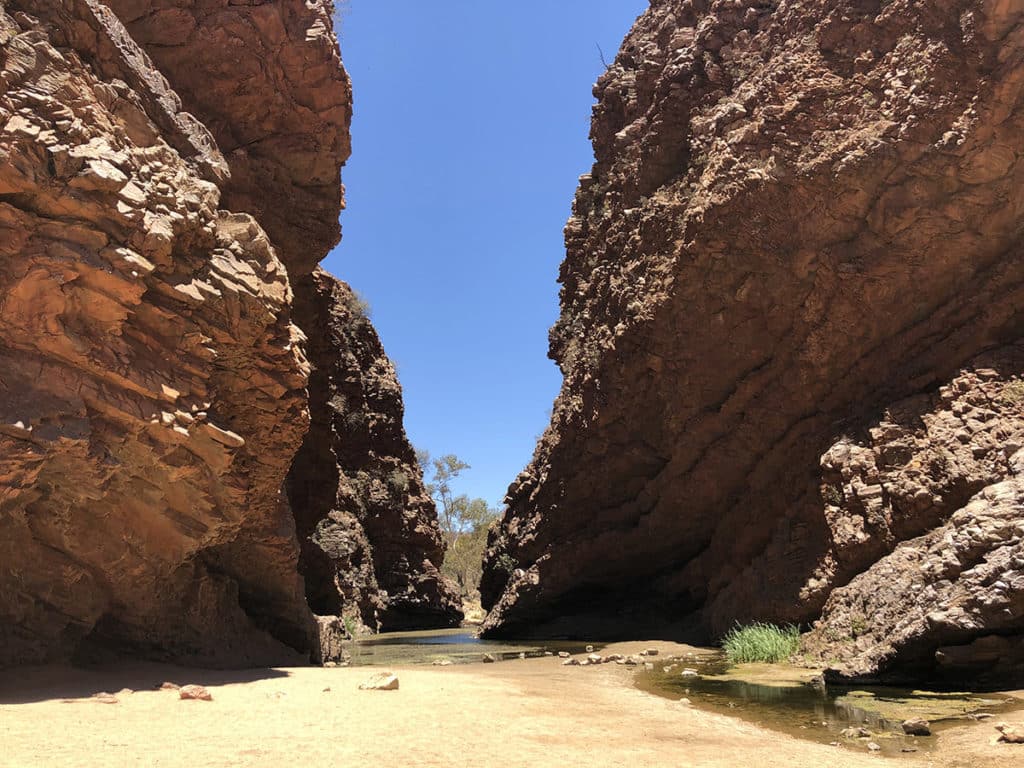
Alice Springs tour: 0.5 day
With 28,000 inhabitants, Alice Springs is a small isolated town in the middle of the desert. You can visit some museums, shops and many Aboriginal art galleries here.
Things to do
- Anzac Hill is one of the must-sees in Alice Springs. This viewpoint located at the top of a hill offers a 360° view of the city and its surroundings. Panels tell the story of the city and its development.
- You can also stroll through the Olive Pink Botanic Garden or visit the Reptile Centre near Alice with a wide variety of reptiles.
- Some museums can also be visited or the Royal Flying Doctor Service, still in operation today.
One day is enough to explore the city of Alice Springs, however if you want to do all the shops and art galleries, plan a little more time.
The Camel Cup which takes place in July of each year is a must if you are around at this time.
The biggest artistic and cultural event, the Alice Desert Festival, takes place in September each year.
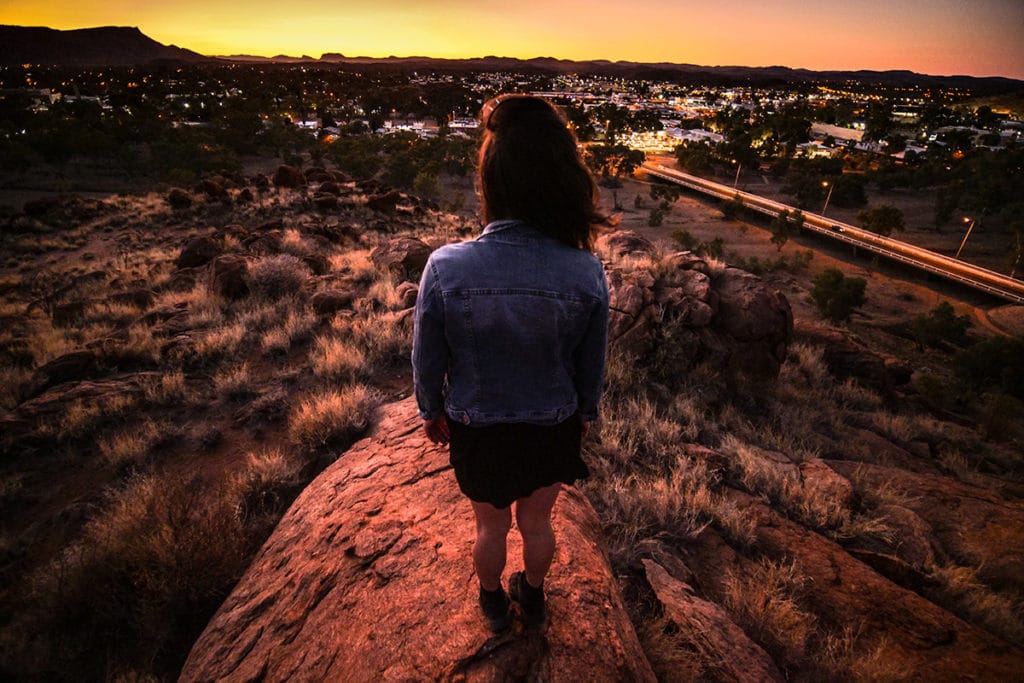
Must-sees in the Red Centre
Rainbow Valley
Rainbow Valley is a natural wonder you won’t want to miss. This great expanse of coloured sandstone rock glistens with hues of purple, orange and gold as the sun’s glow creates a dazzling spectacle. Best seen either at sunrise or sunset, Rainbow Valley is a great day trip from Alice Springs or an overnight camp spot if you want to really experience the wilderness of the Red Centre.
Alice Springs
The capital of Australia’s Red Centre region, Alice Springs is a fascinating and diverse town. If you’re used to towns and cities on the East Coast, this place is going to feel very different…
Uluru
Uluru is probably the number one thing people want to see when they travel to the Red Centre. Ignore everyone who says it’s “just a big rock” and go see it for yourself. The immense power and awe-inspiring qualities of this huge monolith are hard to put into words.
Do you know that wild camels and emus roam the desert! Originally brought to Australia by Indian and Afghani traders as a means of transport, motorcars soon became the preferred way of travelling the great distances of the Red Centre and the camels were left to roam free. Now there are several camel farms in the area that cater to tourists. After all, what better way to take in the views of the arid Outback than on the back of the most iconic desert animal? There’s plenty of options to choose from if you’re looking for a camel tour in the Red Centre, but we recommend the award-winning sunset ride at Uluru. With breathtaking views guaranteed, what a way to end a day in this magical place!
Devils Marbles
Devil’s Marbles is on the drive from Alice Springs to Darwin. There’s something about the way the round boulders sit on top of each other in bizarre patterns, towering above the landscape, with little else in any direction around them! This is a great pitstop if you’re on a road trip – you get to stretch your legs by climbing over the rocks and can enjoy a picnic with a great view too. Stay until sunset to enjoy the view and the campsite close to the boulders.
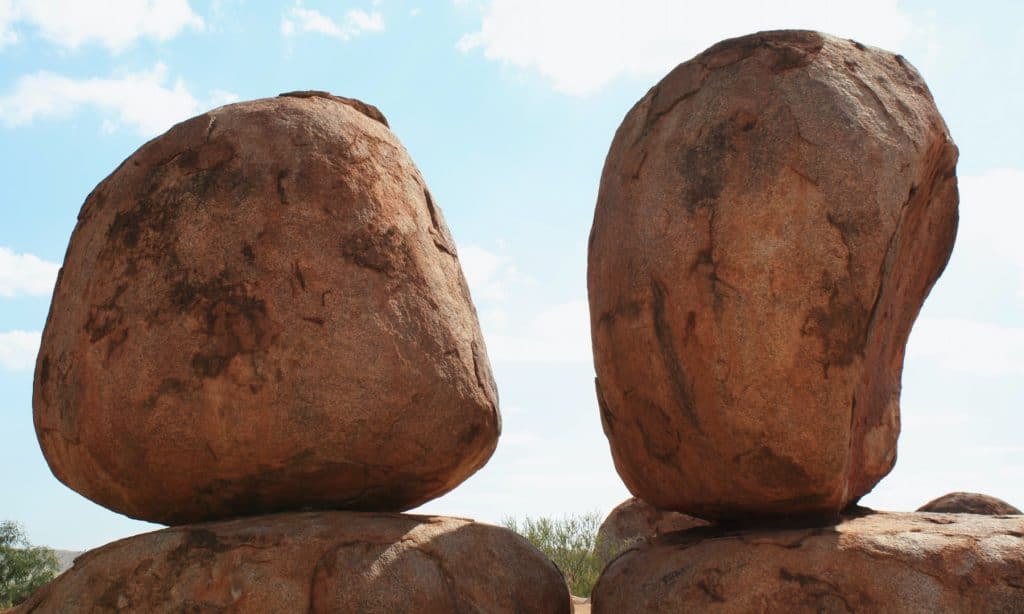
Palm Valley
Palm Valley is named after the Red Cabbage Palm, which is found nowhere else in the world apart from here. The valley is part of Finke Gorge National Park – an area of great significance for the local aboriginal people. This is the place to go to really get a sense of the remoteness of the Outback, with fantastic bush walks, 4WD tracks and camping facilities on offer. The scenery here is amazingly lush and green, due to a precious year-round water supply. The contrast with the red earth is incredibly striking – don’t forget to bring your camera!
West & East MacDonnell Ranges
Situated just west of Alice Springs, Ormiston Gorge is a fantastic spot you need to check out if you’re travelling the Red Centre. With a great walk that meanders around the gorge, stunning views for miles and a refreshing (to say the least!) waterhole to swim in at the end, this is a great spot to spend an afternoon.
The region is home to several important natural and cultural attractions, including the Emily and Jessie Gaps Nature Park, which features a unique rock formation with significant cultural significance to the local Arrernte people.
Kings Canyon
Whereas Uluru stands out from the ground at an impressive height, Kings Canyon seems to bury itself into the earth of Australia Red Centre at an impressive depth. The walls of this natural canyon fall away so sharply that even the trees seem to be holding on for dear life, and a peek over the side of this natural canyon is sure to make you dizzy! Follow the Mereenie Loop – a great unsealed road – around from Uluru to get to King’s Canyon and stay the night nearby if you can. That way you’ll be able to undertake the famous Kings Canyon Dawn Walk, which is one of the most impressive in the whole of Central Australia and well worth getting up early for.
Kata-Tjuta
Right next door to Uluru is the far less famous, but even more beautiful rock formation known as Kata-Tjuta. It’s actually 53km away, but this is considered a short drive in the Red Centre and they are in the same National Park! Whereas Uluru is one giant rock, Kata Tjuta is a series of smaller rocks all deposited together. Their silhouette against the otherwise flat landscape is perhaps even more stunning at sunset than that of their giant neighbour. The Valley of Winds walk, which takes you directly through Kata Tjuta, is an absolute must.
💸 10% Discount on your Insurance Policy
Find here all the information you need and get your 10% Go walkabout promo code for any policy.
Budget for a trip to the Red Centre
Return flight SYD ⇆ ASP: $630
Flying with Qantas, your return ticket from Sydney to Alice Springs will be around 630 AUD per person.
Motorhome rental: $925
Campervan (6‑berth, 10 days incl. insurance)
Fuel: $130 pp
Budget about $600 worth of gas (Diesel) for the whole trip (≈ 208 L @ $2.50). It’s possible to reduce this budget a little by filling up at the cheapest gas stations and reducing the speed/consumption of your vehicle.
Food & groceries: $200pp
It’s a good idea to do a big grocery shop before you leave Alice Springs. If you plan to eat out (there are several steak restaurants in Alice Springs), budget around $650 for four people.
Campsites: $50pp
Budget at least four nights over 10 days at a campsite/caravan park. That’s 2 nights in Uluru, 1 night in Kings Canyon and 1 night in Alice Springs. Total: $2000
Extras: $100pp
Allow a small budget to buy souvenirs and other little miscellaneous things. You’ll also need $38pp for the entry fee for Uluru/Kata Tjuta park.
Travelling solo? A 4‑day/3‑night budget safari (Uluru, Kings Canyon, Kata Tjuta) is about $1,050 return from Alice Springs – often cheaper than hiring a vehicle alone.
Essential passes & permits (AUD, June 2025)
| Pass | Covers | Validity | Adult | Notes |
|---|---|---|---|---|
| Uluru–Kata Tjuta NP | Uluru, Kata Tjuta | 3 days | $38 | Free extension to 5 days; annual $50. Buy online and keep a digital copy. |
| NT Parks Pass | NT government parks incl. Watarrka (Kings Canyon) & Tjoritja / West MacDonnell | 1 day / 14 days / 12 months | $10 / $30 / $60 | Children 5–17 half price. |
| Mereenie Loop Permit | Shortcut Kings Canyon ⇆ West Macs | Calendar day | $5 | Sold in Alice Springs & Kings Canyon info centres; 4WD recommended. |
Practical tips for 2025
- Fuel: $2.30–$2.90 per L at remote roadhouses (Erldunda, Curtin Springs, Kings Canyon). Fill up early and carry a 20 L jerrycan.
- Road conditions: sealed highways except the unsealed Mereenie Loop. Check the NT Road Report and avoid the loop after heavy rain.
- Water & flies: 4 L of water per person per day; fly nets are essential October–April.
- Connectivity: Telstra has the best coverage; free Wi‑Fi at Yulara town square & Kings Canyon Resort.
- Respect culture: drones are banned in Uluru–Kata Tjuta NP; no climbing Uluru; dress modestly at sacred sites.




















